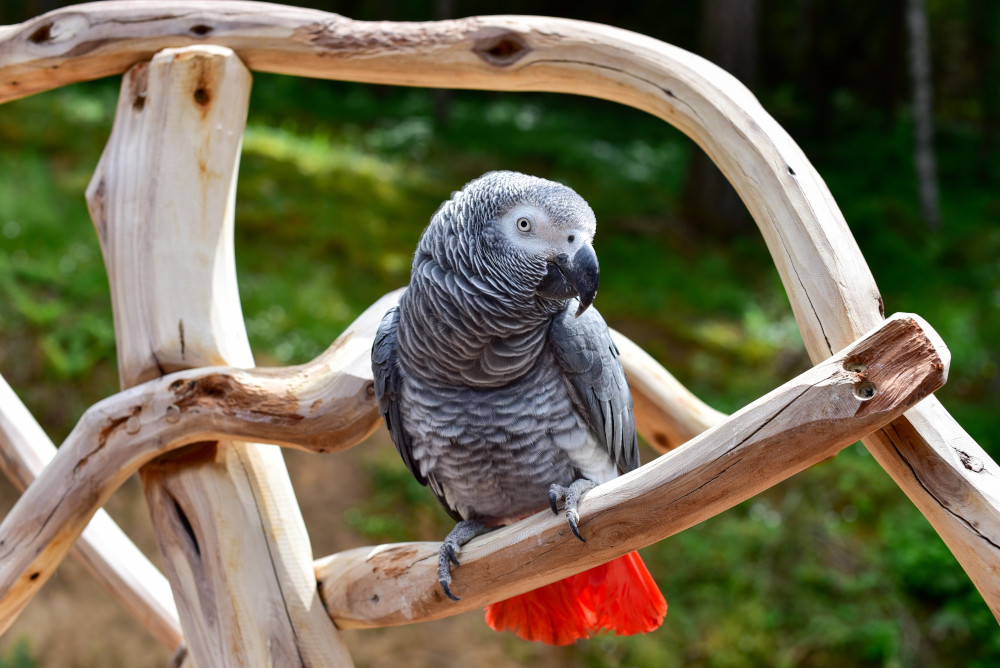How can I keep my birds entertained, alert, and interested in their environment?

Behaviour of wild birds
There is an extensive body of literature devoted to observations of wild bird behaviour. While there are a lot of species-specific differences in the detail of birds’ daily behaviour, their routine is often consistent and usually includes the following elements:
- As the light increases with the dawn of a new day, birds begin to stir. After a short spell of grooming and stretching, they begin to call to each other to assemble the flock. There may be some playing activity and socialising before the flock sets out to search for food.
- The flock often spreads out during this search but the calls of those who have found food soon brings them back together.
- Feeding behaviour depends on whether the birds are ground feeders or canopy feeders, but typically involves eating quickly and then moving to a safer (higher) location to avoid predation while the food is digested.
- Most birds will rest in the middle of the day, napping in the safety of a tree and conserving energy, before resuming their search for food. Some birds will engage in ‘play’ activity throughout the day, especially if there is rainfall.
- As the day starts to draw to a close, the flock will start to head back to the roosting area for the night. Calling for each other and again engaging in playful activities, the flock settles in for the night and, other than occasional calling, sleep soundly through the night.
When this activity is analysed, most researchers agree that wild birds spend 80% of their day searching for, and consuming, food. The rest of the day is spent socialising, grooming, playing, and sleeping.
What happens if we don’t provide appropriate enrichment?
In captivity the 80-20 ratio is virtually flipped; with the food in the same place at the same time each day, the birds only need to spend 10%-20% of their time eating their food. This leaves 80% of the day to be filled with other activities. When a bird is housed by themself, with limited social opportunities available, it is no wonder that some captive birds develop behavioural problems such as over-grooming, stereotypic behaviours, and mental dullness.
Environmental enrichment is defined as “the stimulation of the brain by its physical and social surroundings in an attempt to reduce or overcome problems caused by containment”. Its goals are to alter the bird’s captive behaviour so that it is similar to the normal behaviour of birds in the wild, as described above.
Environmental enrichment therefore aims to provide activities for your bird to engage in that ‘fill’ the currently empty 80% of the day and stimulate the bird’s brain while doing so.
It is generally considered that animals who are behaviourally well-adapted to their environment display ‘species‐specific behaviour’ as permitted by their social and physical environment and not abnormal behaviours. Birds who are not adapting well display a range of abnormal behaviours, including:
- Feather damaging behaving behaviour.
- Stereotypic behaviour (repetitive behaviour that serves no purpose).
- Aggression towards other birds and people.
- Constant screaming.
- Poor socialisation skills e.g., chewing a cagemate’s feathers.
- Excessive sleeping.
Environmental enrichment should therefore be seen as a means of both preventing and, to an extent, treating these abnormal behaviours.
Environmental enrichment
A key concept in environmental enrichment requires that we know ‘species‐typical’ information. It is then important to select enriching strategies that are behaviourally relevant and physically feasible for the bird. Designing an enrichment plan that is incompatible with the animals’ normal behaviour, physical attributes, or their existing environment may not only be fruitless but may also cause frustration and potential harm.
There is a tendency to think that environmental enrichment means just providing some toys or maybe some branches to chew on. This is only a small part of the process. An enrichment plan can include some or all of the following:
- Foraging enrichment
- Physical enrichment
- Sensory enrichment
- Social enrichment
- Occupational enrichment
Foraging enrichment
Foraging is the act of searching for and finding food. As mentioned earlier, wild birds can spend up to 80% of their day foraging and feeding, most actively in the morning and the evening. Foraging therefore has great social and behavioural importance, but is one of the most severely constrained classes of behaviour in captive parrots and other birds; obviously there are potential implications of this common behavioural deficit for bird welfare. Given that we know birds would normally engage in four basic behaviours on a daily basis – foraging, socialising, grooming and resting – removing the ability to forage (by feeding the same food in the same bowl at the same time) leaves a gaping hole that has to be filled with the other behaviours. A bird that lives alone without other birds to socialise with may therefore start to over-groom (feather damaging behaviour) or sleep excessively. They may also develop stereotypic behaviours such as screaming, pacing, biting the wire of their enclosure, etc.
Foraging enrichment therefore seeks to prevent or treat these problems. It requires the bird(s) to chew and sort through, manipulate and/or open objects to get to food. It should reflect the bird’s natural foraging behaviour and can be increased in complexity as the bird’s skill levels increase.
One of the surprising things that researchers have found is that, given a choice between foraging or just eating out of a bowl, birds will always prefer to forage. Here’s some ideas you can implement to allow a bird to spend more time foraging for food.
- Scattering the food over the floor of the cage or aviary.
- Scattering the food in a sand pit or kitty litter tray filled with wooden blocks or recycled paper kitty litter.
- Placing the food in small cardboard boxes or paper parcels that have to be chewed open to access the food.
- ‘Baffle cages’ – wire framed boxes that require beak dexterity to access the food contained inside.
- Multiple food dishes around the cage the cage or aviary, some with food, some without… (birds develop resilience as they learn that they are not always successful).
- Covering the food dishes with paper or cardboard that your bird has to chew through to access the food.
- Pushing treats between the scales of a pine cone, so the bird has to demolish the cone to get to the food.
It is vital that you realise that your bird will have to be taught how to use some of these foraging tools e.g., leaving a cardboard box open till your bird learns there is food in it, and then gradually closing it. Weigh your bird daily and watch for unexpected weight loss, suggesting your bird may be having difficulty locating food.
Physical enrichment
Physical enrichment ranges from objects placed in the bird’s environment (such as toys, swings, ladders, mirrors, etc.) to the environment as a whole (e.g., the space available for your bird to engage in locomotory behaviours such as flying, running, or swimming). This is where the toys that many people provide come in. There are some general guidelines to follow when considering safe enrichment items for birds:
- If the item is constructed of synthetic components, use sturdy and large enough materials to prevent ingestion. Avoid cotton or natural fibres, as these are frequently eaten and can lead to gut obstructions.
- For multiple birds in a cage, provide multiple enrichment devices to reduce item guarding and aggression.
- For birds fearful of new items, slowly introduce the enrichment to the bird’s cage (or your bird to the enrichment area).
Sensory enrichment
Sensory enrichment utilises the bird’s senses such as sight, hearing, smell, and touch. Providing ‘a room with a view’, background noises, videos, toys, etc. can improve a bird’s welfare. It must be used with caution, as some birds may become visibly stressed with loud sounds, certain images, or a lack of security/privacy. Placing a bird’s enclosure in the middle of the family room can certainly provide sensory enrichment but your bird must have the ability to ‘get away from it all’ when the family activities become too much.
Social enrichment
Social enrichment is the social interactions between birds, and between birds and people. It can be indirect, where your bird can see or hear other animals, such as when a bird is in an outdoor cage or aviary. Direct social enrichment includes cage mate pairing, social rooms or flights with numerous birds interacting, and allowing contact between enclosures. Done well, it allows the birds to perform ‘species‐specific’ behaviours (especially when compatible birds are housed together), but it has the potential to have drawbacks and unwanted behaviours such as cage mate aggression. Social enrichment may need to be carefully chaperoned until it is clear the birds can safely intermingle and there is an escape mechanism in case aggression occurs.
Occupational enrichment
Occupational enrichment includes items that elicit activities including problem solving, learning, and choosing and controlling some feature in the bird’s environment. (This is different from the use of puzzle foraging toys that do require problem solving.) Rather these may include items that give birds choices about how they spend their time. For example:
- Although it comes with certain risks, free flight in the house (or even outside) can provide occupational enrichment.
- If you are uncomfortable with free flight outside the house, going for walks together using an appropriate well fitted and safe harness and leash can allow your bird to experience both a change in environment and also sensory enrichment.
- Leaving the indoor cage door open (under supervision), giving your bird the freedom to come and go as and when they want, but without the opportunity to venture outside into a world of potential threats.
A word of warning
Many birds suffer from ‘neophobia’ – the fear of something new. Providing them with new toys and activities must be done gradually to prevent your bird from been overwhelmed (stressed out) or ‘flooded’ – so overwhelmed by the new things that the bird gives up and becomes less interactive and more inactive.
Bibliography
Doneley B (2018) Avian Medicine and Surgery in Practice: Companion and Aviary Birds, 2nd ed. CRC Press
RSPCA Australia believes that captive-bred wild animals should not be kept in a home environment or for companion purposes unless the species has been clearly identified as being suitable for this purpose. It is important that animals living in a home environment can live a good life. This means providing for their physical health and ensuring opportunities to fully express their individual interests and experience good welfare. Inadequate care and husbandry are reported to contribute to common and serious welfare compromises in many captive wild animals living in home environments. For more information see our policy.
The reality is, however, that captive-bred wild animals are kept in home environments despite sometimes not meeting these criteria (e.g., some reptile and bird species). Because of this, the RSPCA has produced these articles on the care and welfare of a variety of commonly kept captive-bred wild animals. The aim is to help people better understand their animals as individuals and provide them with care that keeps them healthy and provides opportunities for positive mental experiences as much as possible in captivity.
Wild animals must not be taken from the wild to be kept as companion animals (pets).
Was this article helpful?
This work is licensed under a Creative Commons Attribution-NonCommercial-NoDerivatives 4.0 International License.



